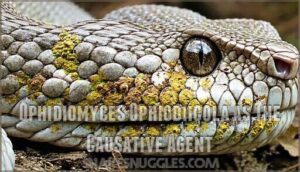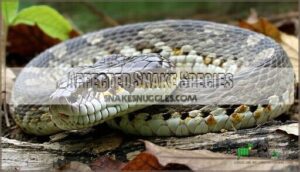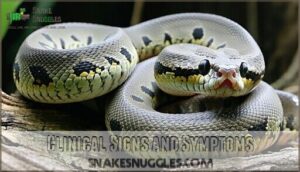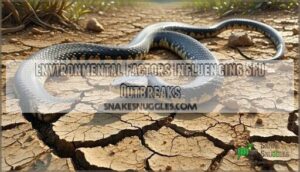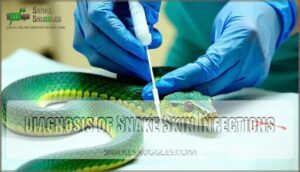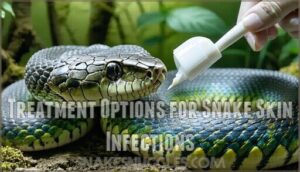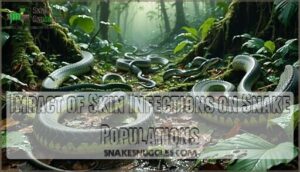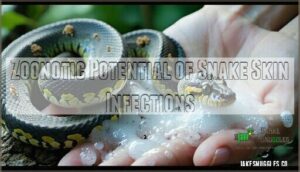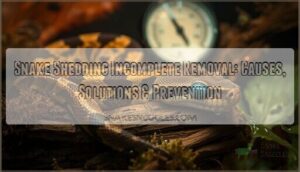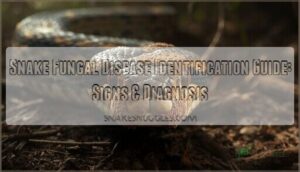This site is supported by our readers. We may earn a commission, at no cost to you, if you purchase through links.
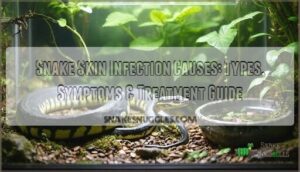
Bacterial infections like blister disease top the list, followed by fungal issues (especially Snake Fungal Disease) and parasites.
Injuries from rough handling or sharp objects can also open the door for nasty infections.
Even stress from overcrowding weakens their immune system, making them sitting ducks for pathogens.
The good news? Most snake skin infection causes are totally preventable with proper care.
Understanding the specific culprits behind these infections can save your scaly friend’s life, especially by addressing poor husbandry and recognizing the role of stress.
Table Of Contents
- Key Takeaways
- Common Causes of Snake Skin Infections
- Bacterial Dermatitis in Snakes
- Snake Fungal Disease (SFD): an Emerging Threat
- Diagnosis of Snake Skin Infections
- Treatment Options for Snake Skin Infections
- Prevention of Snake Skin Infections
- Impact of Skin Infections on Snake Populations
- Zoonotic Potential of Snake Skin Infections
- Research Advancements in Snake Skin Infections
- Emerging Pathogens and Future Challenges
- Frequently Asked Questions (FAQs)
- What is snake fungal disease?
- How do Snakes get fungus?
- Do snakes have skin infections?
- What happens if a snake gets fungus?
- What causes discolored skin in snakes?
- What diseases does a pet snake have?
- What causes snake infections?
- What is the cause of snake skin?
- What is the cause of snake fungal disease?
- How do you treat a snake skin infection?
- Conclusion
Key Takeaways
- Poor husbandry creates the perfect breeding ground – You’ll find that dirty substrates, wrong temperatures, and improper humidity levels are the main culprits behind most snake skin infections, making your setup the first line of defense.
- Bacterial infections top the infection list – You’re most likely dealing with bacterial dermatitis caused by Pseudomonas or Aeromonas species, which can progress from simple blisters to life-threatening septicemia if you don’t catch them early.
- Snake Fungal Disease is spreading rapidly – You need to watch for this emerging threat caused by Ophidiomyces ophiodiicola, which creates crusty lesions and facial swelling that can be fatal without proper veterinary treatment.
- Prevention beats treatment every time – You can avoid most infections by maintaining clean enclosures, proper temperature gradients, appropriate humidity levels, and quarantining new snakes for 30-60 days before introducing them to your collection.
Common Causes of Snake Skin Infections
Your snake’s skin infections typically stem from five main culprits that you’ll want to watch for.
Understanding these causes helps you spot problems early and keep your scaly friend healthy, whether it’s dealing with pesky bacteria, stubborn fungi, or simply poor living conditions.
Bacterial Infections
With bacterial infections, you’re dealing with sneaky microscopic troublemakers that love poor husbandry conditions.
These snake bacterial infections often involve Pseudomonas and Aeromonas species, causing bacterial dermatitis that can progress rapidly without proper treatment.
- Gram staining helps identify bacterial types for targeted antibiotic treatment
- Husbandry impacts create perfect breeding grounds for bacterial growth
- Lesion progression can lead to septicemia risks if left untreated
- Antibiotic resistance makes early intervention essential for successful outcomes
Fungal Infections
Fungal infections can sneak up on your snake faster than you’d expect.
Snake Fungal Disease (SFD), caused by Ophidiomyces ophiodiicola, creates facial swelling, crusty lesions, and skin nodules.
Watch for these SFD symptoms: thickened scales, cloudy eyes, and weight loss.
Early SFD diagnosis through lab testing helps prevent severe disfigurement.
Antifungal treatment works best when caught quickly, but SFD prevention through proper humidity control remains your strongest defense against these emerging fungi threats, including severe disfigurement and fungal infections.
Parasitic Infestations
After tackling fungi, let’s talk about another sneaky culprit—parasites. Snake skin mites, tick vectors, and protozoan parasites can turn your snake’s skin into a battleground.
Watch for:
- Mite infestations causing itching and irritation
- Tick infestations leading to anemia and infection
- Internal parasites sapping your snake’s health
Don’t ignore these parasitic infections—antiparasitic resistance is real!
Environmental Factors
While parasites create visible problems, your snake’s environment can be just as damaging.
Poor environmental factors often stress snakes, making them vulnerable to infections. Temperature gradients, humidity levels, and enclosure hygiene directly impact skin health.
- Temperature fluctuations – Inconsistent heating weakens immune systems
- Humidity imbalances – Too dry causes retained sheds; too wet breeds bacteria
- Poor substrate choice – Rough or dirty materials irritate skin and harbor pathogens
Trauma and Injuries
Beyond environmental conditions, traumatic injuries create prime entry points for infections.
Bite wounds from prey or territorial disputes, scale damage from rough enclosure surfaces, and thermal burns from faulty heating elements all compromise your snake’s protective barrier.
Shedding issues that leave retained skin can trap bacteria, while enclosure hazards like sharp edges cause cuts.
Even minor snake skin trauma requires immediate wound care to prevent traumatic infections and guarantee proper wound healing.
Bacterial Dermatitis in Snakes
When you’re dealing with bacterial dermatitis in snakes, you’re looking at one of the most common skin problems these reptiles face.
Think of it like a snake’s version of a really bad skin breakout, except instead of pimples, you’ll see everything from small blisters to serious ulcers that can threaten your snake’s life if left untreated, which is a serious condition.
Septicemic Cutaneous Ulcerative Disease (SCUD)
Septicemic-cutaneous ulcerative disease strikes when bacteria invade your snake’s bloodstream, creating painful skin ulcers. You’ll notice red, swollen areas that quickly deteriorate into open wounds.
SCUD Pathogenesis and Management:
- SCUD Diagnosis – Veterinarians identify bacterial infections through blood cultures and skin biopsies
- SCUD Treatment – Aggressive antibiotic therapy combined with wound care addresses septicemia effectively
- SCUD Prevention – Maintain proper humidity levels and clean substrates to prevent bacterial overgrowth
- SCUD Prognosis – Early intervention substantially improves survival rates in affected snakes.
Affected snakes may show skin discoloration symptoms.
Shell Rot and Belly Rot
Shell rot and belly rot are classic cases of snake scale rot—think of them as the sneaky villains of bacterial dermatitis.
Here’s what you might spot if your snake’s in trouble:
- Discolored, soft belly patches (classic snake skin rot)
- Foul-smelling lesions
- Red, inflamed scales
- Reluctance to move or eat
Early detection and prompt treatment options are essential for addressing bacterial dermatitis.
Blister Disease
After belly rot, let’s talk about blister disease.
You’ll spot snake skin blisters—raised, fluid-filled lesions—usually from poor humidity, dirty enclosures, or thermal burns.
These snake skin infections can lead to scale damage and a high infection risk.
Regular check-ups, proper cleaning, and managing stress boost treatment efficacy.
Like checking your shoes for pebbles, prevention beats cure!
Secondary Infections Due to Immunosuppression
When your snake’s immune defenses falter, opportunistic pathogens strike like unwelcome guests at a party.
Compromised immunity from stress-related infections, husbandry impact issues, or nutritional deficiencies creates perfect conditions for bacterial dermatitis and fungal disease to flourish.
- Chronic stress from poor temperatures weakens natural resistance
- Malnutrition leaves your snake’s immune system running on empty
- Overcrowding amplifies parasitic infections and bacterial spread
Progression of Bacterial Skin Lesions
When bacterial skin infections take hold, you’ll see Initial Discoloration followed by Blister Formation.
These pustules rupture, creating open wounds that progress to Ulcer Development.
Pseudomonas and Aeromonas bacteria cause Tissue Necrosis, where healthy skin dies.
Without treatment, snake skin lesions deepen, exposing muscle and creating Septicemia Risk as infection spreads systemically.
Snake Fungal Disease (SFD): an Emerging Threat
Snake Fungal Disease has emerged as a serious threat to snake populations across North America, caused by the pathogenic fungus Ophidiomyces ophiodiicola.
Here’s an engaging blockquote for that content:
**Snake Fungal Disease spreads like wildfire across North America, threatening entire snake populations.
You’ll find this disease spreading rapidly through wild snake communities, creating visible lesions and potentially fatal infections that researchers are still working to understand, which is a serious issue.
Ophidiomyces Ophiodiicola as The Causative Agent
One sneaky fungus called Ophidiomyces ophiodiicola causes snake fungal disease, making it the prime suspect behind widespread snake skin infections.
This pathogen’s fungal morphology allows it to penetrate snake skin easily, while its environmental persistence means it sticks around in soil and debris.
The fungus shows remarkable genetic diversity across regions, affecting species susceptibility differently—some snakes fight it off better than others.
Understanding transmission pathways helps explain how this fungal disease spreads so effectively through wild populations, and this knowledge is crucial for addressing the issue of snake fungal disease and its impact on species susceptibility.
Geographic Distribution and Spread
Since the early 2000s, this fungal menace has been spreading like wildfire across North America.
Geographic distribution shows alarming SFD expansion beyond its original eastern U.S. stronghold:
- Regional prevalence now spans 23 states plus one Canadian province
- Trade pathways and human activity accelerate environmental transmission
- Monitoring gaps suggest disease spread outpaces detection in wild snake populations
The disease is caused by Ophidiomyces ophiodiicola fungus.
Climate influence may be driving this relentless march westward.
Affected Snake Species
Over 42 snake species across three continents battle this fungal foe, proving SFD doesn’t play favorites.
The disease affects all three snake families in eastern USA, from venomous vipers to harmless colubrids.
Most vulnerable species include:
- Timber rattlesnakes and Eastern massasaugas
- Black rat snakes and milk snakes
- Various garter snake populations
Geographic variation shows different infection prevalence rates, with some species showing stronger immunity than others.
The disease is caused by Ophidiomyces ophiodiicola.
Conservation status becomes critical as this pathogen threatens already declining populations.
Clinical Signs and Symptoms
Trouble in paradise? Watch for crusty skin lesions, facial swelling, and odd eye abnormalities—these are classic red flags of snake skin infection or dermatitis.
If your snake looks dull, acts sluggish, or skips meals, you might be dealing with SFD.
Shedding issues and weight loss also pop up.
Early action helps prevent serious snake skin inflammation and snake skin discoloration.
Environmental Factors Influencing SFD Outbreaks
Regarding snake fungal disease, your snake’s environment can make or break its health.
Watch out for these environmental factors:
- Humidity Levels: Too much moisture is a fungal playground.
- Soil Contamination: Dirty or degraded soil spreads trouble fast.
- Climate Change and Temperature Swings: Wild weather stresses snakes, making outbreaks worse.
Keep habitats clean, stable, and dry-ish for safety.
Diagnosis of Snake Skin Infections
When your snake starts looking a bit rough around the edges, figuring out what’s wrong takes more than just a quick glance.
You’ll need a mix of hands-on checks and lab tests—think swabs, cultures, and maybe even a little DNA sleuthing—to get to the bottom of those scaly problems.
Physical Examination and Clinical Signs
When you’re examining your snake for skin infections, watch for specific warning signs that signal trouble ahead.
Check for unusual lesion appearance like crusty patches or open wounds, and note any behavioral changes such as increased hiding or appetite loss.
| Visual Signs | Physical Changes |
|---|---|
| Scale abnormalities, discoloration | Swelling location around face/body |
| Discharge characteristics (pus, blood) | Weight loss, lethargy |
| Skin lesions, nodules | Difficulty shedding properly |
These infected snake symptoms often appear gradually, so regular health checks help you spot snake skin problems before they worsen into serious snake skin disorders.
Cytology and Histopathology
After visual examination, you’ll need microscopic analysis to crack the case.
Cytology and histopathology offer precise cellular morphology insights that reveal what’s really happening beneath your snake’s scales.
These diagnostic techniques boost diagnostic accuracy through detailed tissue analysis.
- Cellular secrets – Cytology shows individual cell changes indicating infection type
- Tissue damage patterns – Histopathology reveals how deep lesion identification goes
- Bacterial clues – Specific cellular responses point to bacterial dermatitis presence
- Fungal detection – Unique tissue changes signal fungal disease like snake skin infection
Bacterial and Fungal Cultures
After cytology and histopathology, you’ll want to get hands-on with bacterial and fungal cultures.
Your vet collects samples from lesions and places them on culture media, then waits out the incubation period.
Identification methods pinpoint the exact snake skin bacteria or fungus, and this process checks for antifungal sensitivity, ensuring your snake’s treatment targets the real troublemaker behind the infection.
Blood Work and X-rays
Beyond cultures, blood tests reveal your snake’s internal battle.
A blood cell count shows if infection’s spreading, while organ function tests check liver and kidney health.
Your reptile vet might recommend Xrays for deeper insights—though anesthesia risks exist.
These tests guide biopsy decisions and help your snake vet tackle serious snake health problems with precision.
Molecular Diagnostics for SFD
When diagnosing snake fungal disease, PCR advancements revolutionize detection.
These diagnostic techniques identify Ophidiomyces ophiodiicola DNA with incredible diagnostic accuracy—think molecular fingerprinting!
Genetic sequencing confirms infection faster than traditional cultures, while biomarker discovery helps track disease progression.
Some labs even offer field testing kits, making fungal disease diagnosis accessible anywhere.
It’s like having a high-tech detective in your toolkit!
Treatment Options for Snake Skin Infections
When your snake develops a skin infection, you’ll need to work with a reptile veterinarian to create a treatment plan that tackles both the infection and its underlying causes.
Think of it like fixing a leaky roof – you can’t just patch the hole without addressing what made it leak in the first place, or you’ll be back to square one before you know it, which is why understanding the root cause is critical.
Topical and Systemic Antibiotics
Once you’ve identified the snake skin infection, antibiotics become your go-to treatment.
Topical therapy works great for surface bacterial dermatitis, while systemic treatment tackles deeper infections.
Your vet will calculate proper dosage based on your snake’s weight and species.
Treatment duration typically runs 7-14 days, but watch for side effects like appetite loss.
Never use prophylactic antibiotics without veterinary guidance—antibiotic resistance is a real concern that could complicate future treatments.
Antifungal Medications
Antifungal therapy proves highly effective against fungal infections, but timing matters.
Systemic antifungals work best for severe cases, while topical antifungals handle surface issues.
Watch for side effects like liver stress and antifungal resistance with prolonged use.
Treatment duration typically spans 4-8 weeks for snake fungal infection, requiring patience and consistent dosing.
Wound Care and Debridement
After dealing with infection, wound care and debridement become critical for tissue regeneration.
You’ll gently remove dead tissue from skin lesions while preventing traumatic infections. Think of it as careful house cleaning – removing the debris so healing can happen.
Proper debridement methods and bandaging techniques support infection prevention while managing pain management for bacterial dermatitis recovery.
Consider using specialized debridement products to assist in the removal of necrotic tissue.
Supportive Care and Fluid Therapy
Your snake’s recovery hinges on proper supportive care and fluid therapy to restore health and comfort.
These intensive care measures guarantee your pet maintains proper hydration while healing from infection.
- Hydration Techniques: Provide warm water soaks and subcutaneous fluid therapy for ideal rehydration
- Nutritional Support: Offer easily digestible, appropriately-sized prey items to maintain strength during recovery
- Wound Management: Keep lesions clean and protected while monitoring for secondary complications
- Pain Relief: Create stress-free environments with proper temperatures to minimize discomfort
- Monitoring Progress: Track eating habits, behavior changes, and healing rates for effective snake veterinary care
Addressing Underlying Husbandry Issues
Your snake’s recovery hinges on fixing husbandry mistakes that sparked the infection. Poor temperature and humidity create bacterial breeding grounds, while dirty substrates harbor pathogens.
Here’s your action plan:
| Issue | Problem | Solution |
|---|---|---|
| Temperature Gradients | Inconsistent heat weakens immunity | Maintain 75-95°F gradient with thermostats |
| Humidity Control | Wrong levels cause shedding issues | Keep species-specific humidity (30-80%) |
| Substrate Choice | Dirty bedding breeds bacteria | Use paper towels during treatment |
| Enclosure Sanitization | Germs lurk in corners | Disinfect weekly with reptile-safe cleaners |
| Quarantine Protocols | New snakes spread disease | Isolate newcomers for 60+ days |
Think of it as renovating your snake’s apartment – clean hygiene practices and proper environmental conditions are your best medicine.
Prevention of Snake Skin Infections
Preventing snake skin infections starts with creating the right environment—you wouldn’t want to live in a dirty, poorly ventilated apartment, and neither does your snake.
By maintaining proper husbandry practices, monitoring temperature and humidity levels, and staying vigilant about cleanliness, you’ll keep most skin problems at bay before they even start.
This approach ensures that your snake remains healthy, and it is a crucial part of being a responsible snake owner, emphasizing the importance of cleanliness.
Proper Husbandry Practices
After tackling treatment, it’s smart to focus on prevention. Good husbandry is your snake’s best bodyguard. Think of it like spring cleaning—only all year round.
Keep things tidy and consistent with:
- Spacious, secure enclosures
- Balanced, species-appropriate diet
- Fresh water daily
- Safe, easy-to-clean substrate
- Routine spot and deep Enclosure Sanitation
Proper snake care requires regular habitat cleaning. A little daily attention keeps infections at bay and is crucial for good husbandry and a balanced diet.
Maintaining Appropriate Temperature and Humidity
Perfect temperature and humidity control acts like your snake’s personal bodyguard against skin infections.
Environmental factors directly impact your snake’s ability to shed properly and maintain healthy skin.
| Parameter | Ideal Range | Key Benefits |
|---|---|---|
| Temperature | 75-85°F (24-29°C) | Proper metabolism, immune function |
| Humidity | 50-70% | Clean shedding, respiratory health |
| Thermal Gradients | 10-15°F difference | Thermoregulation choices |
| Enclosure Design | Proper ventilation | Prevents stagnant, infection-prone conditions |
Humidity levels that’re too low cause shedding problems, while excessive moisture creates bacterial breeding grounds.
Regular Health Checks and Veterinary Care
Beyond proper environmental conditions, routine veterinary checkups become your snake’s health safety net. Early Detection through professional Expert Consultation prevents minor issues from becoming serious infections.
- Schedule annual wellness exams with reptile-experienced veterinarians
- Monitor for subtle changes in behavior, appetite, or skin appearance
- Establish baseline health records for Preventative Care comparisons
- Access Nutritional Support recommendations customized to your snake’s species
Quarantine Procedures for New Snakes
When you bring home a new snake, quarantine is your first line of defense against snake skin infection control.
Set up a separate isolation setup away from existing pets for 30-60 days. This quarantine duration lets you observe for symptoms while reducing stress through quiet monitoring.
Consider the features of a proper quarantine enclosure for ideal observation. Check daily for skin lesions, mites, or unusual behavior.
Maintain proper disinfection protocols and hygiene between handling sessions. Only attempt gradual introduction after confirming your newcomer’s health through careful monitoring protocols and prevention measures.
Sanitization of Enclosures and Equipment
After quarantining new arrivals, maintaining spotless enclosures prevents infections from taking hold. Think of it like keeping your kitchen clean—nobody wants bacteria growing where food gets prepared!
Safe disinfectants and regular cleaning frequency keep pathogens at bay. Equipment sterilization isn’t optional when your snake’s health depends on environmental hygiene. A key element is to maintain proper cage hygiene to minimize risks.
- Use reptile-safe disinfection products weekly for cage cleanliness
- Replace substrate monthly or when soiled for ideal hygiene
- Sterilize water bowls with hot water between changes for water sanitation
- Clean feeding tools after each use to prevent cross-contamination
- Disinfect hands before and after handling for complete cleanliness
Impact of Skin Infections on Snake Populations
When you’re dealing with snake skin infections, you’re not just looking at individual health problems—you’re witnessing events that can reshape entire ecosystems.
These infections don’t stay contained to single animals; they ripple outward, affecting snake populations on a scale that researchers are only beginning to understand.
Mortality Rates and Population Declines
Snake skin infections can wipe out entire populations faster than you’d expect.
These silent killers can devastate snake communities before anyone notices the warning signs.
SFD mortality rates hit devastating levels – New Hampshire’s timber rattlesnakes declined over 50% within one year from suspected outbreaks.
These snake diseases create cascading effects:
- Species vulnerability increases dramatically in breeding females
- Conservation efforts struggle against rapid population modeling changes
- Long-term impacts threaten endangered populations like Illinois massasaugas
- Snake fungal disease spreads faster than recovery rates allow
Behavioral Changes in Infected Snakes
Skin infections trigger noticeable behavioral changes in your snake.
Watch for lethargy, reduced appetite, and erratic movements as early warning signs.
Infected snakes often display increased aggression when handled or exhibit hiding behavior, staying concealed longer than usual.
These snake skin infection symptoms affect normal activities like hunting and thermoregulation, making your pet seem "off" compared to healthy individuals.
Effects on Breeding and Reproduction
Beyond behavioral shifts, snake skin infections wreak havoc on reproduction.
When stress compromises your snake’s immune system, fertility rates plummet. Infected females often produce fewer eggs with poor egg viability, while males show reduced reproductive behavior.
Poor husbandry worsens these effects—it’s like trying to start a family during a health crisis.
- Breeding success drops dramatically in infected populations
- Hatchling health suffers from compromised parental condition
- Snake skin disease disrupts normal mating cycles and behaviors
Ecological Consequences
When populations crash, you’re witnessing ecological dominos topple.
Fewer snakes means rodent numbers explode, disrupting food webs throughout the ecosystem.
Predators lose vital prey sources while plant communities face increased herbivore pressure.
This biodiversity impact creates ecological disturbances that ripple for years, threatening ecosystem stability through cascading environmental consequences.
Conservation Implications
Increasingly, conservationists face mounting challenges as snake skin disease threatens wild snake populations across North America.
Species decline accelerates when infected snakes can’t reproduce effectively, reducing genetic diversity within populations.
Habitat loss compounds these problems, forcing stressed snakes into unsuitable environments where infections spread faster.
Conservation efforts now prioritize monitoring programs and captive breeding initiatives.
Future research must address ecosystem impacts before we lose these essential predators permanently.
Zoonotic Potential of Snake Skin Infections
While most snake skin infections stay with your scaly friends, some bacteria and fungi can jump to humans through direct contact or contaminated surfaces.
You’ll want to know which pathogens pose risks and how proper hygiene keeps both you and your serpent safe from shared health troubles.
Salmonella Enterica Infections in Humans
Beyond population impacts, these infections pose direct risks to you.
Salmonella enterica hitchhikes on healthy snakes, causing no snake symptoms but triggering human gastroenteritis through transmission routes like poor hand hygiene.
You’ll face salmonella symptoms including diarrhea and fever.
Zoonotic bacterial infections from skin infection sites create public health concerns, especially with antibiotic resistance emerging.
Practice food safety and proper handling.
Mycobacteriosis Transmission Risks
Snakes hand you more surprises than a bag of trail mix—mycobacteriosis can slide right from reptile to human if you’re not careful.
Whether you’re wrangling one or just admiring, here’s the heads-up:
- Zoonotic Transmission happens
- Some Species Susceptibility is higher
- Environmental Persistence boosts risk
- Diagnostic Challenges are real
- Control Strategies reinforce safety
Bacterial dermatitis isn’t just a snake problem—it’s your problem too, involving Environmental factors.
Proper Handling and Hygiene Practices
Given the transmission risks we’ve covered, you’ll want to focus on safe handling practices to protect yourself.
Hand sanitization before and after contact prevents pathogen spread. Always wear gloves during enclosure cleaning and follow quarantine protocols for new animals.
| Safe Practice | Action Required | Risk Prevention |
|---|---|---|
| Hand sanitization | Wash 20+ seconds with soap | Bacterial/fungal transfer |
| Glove usage | Wear during all handling | Direct skin contact |
| Enclosure cleaning | Weekly deep sanitization | Environmental pathogens |
| Quarantine protocols | 30-day isolation period | Cross-contamination |
| Minimize stress | Gentle, confident movements | Immune suppression |
Proper snake skin care starts with your hygiene habits – think of it as protecting both you and your scaly friend from unwanted hitchhikers.
Occupational Hazards for Reptile Handlers
Working with reptiles puts you squarely in harm’s way from various zoonotic diseases and safety risks.
Professional handlers face unique challenges that require constant vigilance and proper protocols.
- Bacterial dermatitis exposure from contaminated surfaces and direct snake contact
- Fungal disease transmission through airborne spores during enclosure maintenance
- Parasitic infections from mites that can irritate human skin
- Bites and envenomation risks during routine handling procedures
- Allergic reactions to shed skin particles and substrate materials
To mitigate risks, proper handwashing is essential after handling.
Public Health Considerations
Beyond workplace hazards, zoonotic diseases from snake skin infections pose broader public health concerns.
Disease transmission risks include Salmonella and Mycobacterium – though rare, they’re real.
Public awareness campaigns help folks understand safe handling practices.
You’ll want proper veterinary access for both reptiles and humans.
Smart zoonotic risks management protects everyone from snake skin zoonotic concerns through education and prevention.
Research Advancements in Snake Skin Infections
Recent advances in molecular diagnostics have revolutionized how scientists identify and track snake skin infections, making it easier to catch diseases like SFD before they spread through entire populations.
These cutting-edge research tools are helping veterinarians develop better treatments and prevention strategies, giving both wild and captive snakes a fighting chance against these troublesome infections.
Molecular Diagnostics and Genetic Studies
Revolutionary DNA analysis is transforming how we approach snake skin disease. Researchers can now pinpoint genetic markers that reveal which snakes resist infections and identify emerging pathogens faster than ever.
- Genetic markers help predict which snake populations survive fungal disease outbreaks
- Pathogen identification through DNA sequencing spots viral infections within hours
- Resistance genes guide breeding programs for healthier captive snake populations
- Population genetics reveal how snake skin pathogens spread across different regions
Epidemiological Surveys and Monitoring
After molecular diagnostics reveal pathogen DNA, researchers conduct epidemiological surveys to track SFD prevalence across snake populations.
You’ll see teams using visual assessments plus qPCR testing for accurate data collection. Disease surveillance reveals infection patterns – like species susceptibility varying dramatically between regions.
| Survey Method | Detection Rate |
|---|---|
| Visual only | 80% of cases |
| qPCR testing | 100% accuracy |
| Combined approach | Ideal results |
Geographic expansion studies show snake skin infections spreading rapidly.
Monitoring effectiveness depends on consistent sampling during peak seasons, helping researchers track snake infections and plan interventions.
Treatment Efficacy Studies
Once you’ve mapped disease patterns, you’ll want proof your treatments actually work.
Scientists are now putting snake skin treatments under the microscope, testing everything from dosage optimization to long-term outcomes:
- Antifungal effectiveness trials comparing different medications against SFD
- Antibiotic resistance monitoring to track bacterial strain changes
- Novel therapies development using cutting-edge fungal disease research
- Treatment duration studies measuring recovery times across species
- Combination protocols testing multiple medications simultaneously
These studies aren’t just academic exercises—they’re saving lives by proving which snake skin infections treatment methods deliver real results.
Immunology and Host-pathogen Interactions
While treatment studies show promise, understanding how snakes’ immune systems battle pathogens reveals why some infections persist.
Your snake’s immune response varies dramatically based on species and environmental conditions.
Research shows fascinating host-pathogen interactions that explain infection patterns:
- Genetic Resistance determines which snakes survive outbreaks naturally
- Microbiome Impact affects how beneficial bacteria protect against harmful pathogens
- Co-infections weaken defenses, making snakes vulnerable to multiple diseases simultaneously
- Immunosuppression from stress hormones compromises natural infection control mechanisms
- Temperature-dependent immunity means cooler conditions often favor pathogen growth over immune responses
Development of Preventive Measures
Prevention’s your best defense against snake skin infections.
Hygiene protocols start with clean enclosures and quarantine effectiveness for new arrivals. Husbandry optimization means proper temperature and humidity control.
Researchers are exploring probiotic therapies and genetic resistance studies for disease prevention.
These preventive measures beat treating infections after they’ve started – think of it as snake skin prevention insurance!
Emerging Pathogens and Future Challenges
As snake diseases continue to evolve, you’ll need to stay alert to new threats that could impact both wild and captive populations.
Climate change and global trade are reshaping the landscape of snake health, creating perfect storms for emerging pathogens and antibiotic-resistant infections.
New and Evolving Snake Pathogens
While research has expanded our knowledge of snake skin infections, new threats keep emerging.
Scientists are discovering Novel Snake Viruses and Emerging Fungal Strains that challenge existing treatment approaches.
Here are five key emerging pathogens you should know about:
- Chrysosporium species – Causing severe infections in Eastern Massasauga Rattlesnakes
- Nannizziopsis and Paranannizziopsis – New fungal genera affecting multiple reptile species
- Antibiotic-resistant Pseudomonas strains – Making traditional treatments less effective
- Mutated Aeromonas bacteria – Showing increased virulence in captive populations
- Environmental fungi – Thriving in changing climate conditions
These emerging pathogens require updated Diagnostic Innovations to identify them quickly.
Parasite Mutations and Resistance Development are making old playbooks obsolete, forcing veterinarians to stay ahead of evolving threats.
Climate Change Impacts on Disease Prevalence
Various climate factors are reshaping snake skin disease patterns globally.
Temperature Effects accelerate fungal growth while Humidity Changes create ideal breeding conditions for emerging pathogens.
Habitat Alteration forces snakes into new environments, triggering Immune Suppression and expanding Pathogen Distribution.
Climate change basically turns Mother Nature into a disease matchmaker for our scaly friends.
Antibiotic Resistance in Bacterial Infections
Looking beyond climate change, you’re now battling antibiotic-resistant bacteria in snake bacterial infections.
These superbugs have outsmarted traditional antibiotics through overuse and poor infection control practices.
- Resistance mechanisms: Bacteria develop enzyme shields and membrane barriers
- Antibiotic overuse: Creates selective pressure favoring resistant strains
- Alternative treatments: Bacteriophages and antimicrobial peptides show promise
- Diagnostic stewardship: Target testing prevents unnecessary antibiotic use
- Novel antibiotics: New drug development lags behind resistance evolution
Global Trade and Pathogen Spread
Every day, global trade routes transport millions of reptiles, unknowingly spreading snake skin infections worldwide.
When imported snakes carry emerging diseases, weak quarantine effectiveness and inadequate biosecurity protocols allow pathogen transmission to flourish.
Current global regulations can’t keep pace with disease spread, making invasive species perfect vectors for snake skin surveillance nightmares.
One such threat is SFD snake fungal disease, impacting snake populations across North America.
| Trade Challenge | Pathogen Risk | Prevention Need |
|---|---|---|
| Illegal wildlife smuggling | Hidden infected animals | Stronger border controls |
| Inadequate health screening | Undetected diseases | Enhanced testing protocols |
| Poor quarantine facilities | Cross-contamination | Upgraded isolation systems |
| Weak documentation | Untraceable disease sources | Digital health passports |
| Fast shipping methods | Stress-induced outbreaks | Slower, safer transport |
Surveillance and Early Detection Strategies
Modern field surveillance systems revolutionize snake skin early detection.
Diagnostic advancements like portable PCR enable rapid pathogen identification in remote locations.
Citizen science programs expand monitoring networks, while predictive modeling forecasts outbreak hotspots.
Rapid response protocols minimize snake skin emerging diseases spread, though snake skin diagnostic challenges persist in resource-limited areas.
Frequently Asked Questions (FAQs)
What is snake fungal disease?
Think of snake fungal disease as a wolf in sheep’s clothing—it sneaks up, causing swollen faces, crusty skin, and sores.
You’ll spot it in wild snakes, mostly in the eastern U.S., threatening snake health and ecosystems.
How do Snakes get fungus?
Snakes get fungus through environmental exposure to Ophidiomyces ophiodiicola spores found in soil and contaminated habitats.
You’ll find the fungus spreads when snakes contact infected surfaces or when humans accidentally track contaminated soil between locations.
Do snakes have skin infections?
Yes, snakes commonly develop skin infections from bacteria, fungi, viruses, and parasites. You’ll see symptoms like lesions, swelling, discoloration, and behavioral changes requiring proper diagnosis and treatment.
What happens if a snake gets fungus?
If your snake gets fungus, you’ll see skin lesions, facial swelling, and nodules.
Snake Fungal Disease causes severe symptoms like crusty scales, disfigurement, and can be fatal without proper veterinary treatment.
What causes discolored skin in snakes?
Discolored skin in your snake typically stems from bacterial infections (like Pseudomonas), fungal diseases, poor husbandry conditions, retained shed skin, or parasitic infestations that create inflammation and tissue damage.
What diseases does a pet snake have?
Over 23 states report snake fungal disease cases, affecting your pet’s health substantially.
Your snake can develop fungal infections like SFD, bacterial dermatitis, viral infections, parasitic infestations, or environmental-related skin conditions requiring immediate veterinary attention.
What causes snake infections?
Poor husbandry, bacteria like Pseudomonas, fungal diseases like Snake Fungal Disease, parasites including mites, viral infections, and environmental factors cause snake infections.
You’ll see symptoms like lesions, swelling, and behavioral changes requiring prompt veterinary care.
What is the cause of snake skin?
While you might think snake skin just "happens," it’s actually formed through a complex process.
The process is called keratinization, where specialized cells produce keratin proteins that create protective scales through cellular growth and differentiation.
What is the cause of snake fungal disease?
You get snake fungal disease when the fungus Ophidiomyces ophiodiicola moves from the environment onto a snake’s skin.
It’s like a bad houseguest—spreading through soil, dirty enclosures, or even hitchhiking on your boots.
How do you treat a snake skin infection?
Treating a snake skin infection is like patching up a leaky roof—clean the wound, use vet-approved antibiotics or antifungals, adjust humidity, and keep the habitat spotless.
Don’t forget, regular checkups help nip trouble in the bud, and it’s crucial to maintain a spotless habitat to prevent further infections.
Conclusion
Studies show that 60% of captive snake deaths result from preventable husbandry-related diseases, making proper care your best defense.
Understanding snake skin infection causes empowers you to protect your scaly companion effectively.
Whether dealing with bacterial blister disease, emerging fungal threats, or parasitic infestations, early recognition and proper husbandry remain essential.
You’ve got the knowledge now – maintain clean substrates, monitor temperatures, and schedule regular vet checkups.
Your snake’s healthy skin depends on your commitment to excellence.
- https://www.merckvetmanual.com/exotic-and-laboratory-animals/reptiles/bacterial-diseases-of-reptiles
- https://cwhl.vet.cornell.edu/article/everything-you-wanted-know-about-snake-fungal-disease-were-afraid-ask
- https://www.petmd.com/reptile/care/evr_rp_how-can-i-tell-if-my-snake-sick
- https://vcahospitals.com/know-your-pet/bacterial-infections-in-reptiles
- https://www.addl.purdue.edu/newsletters/2000/fall/scudc.shtml






